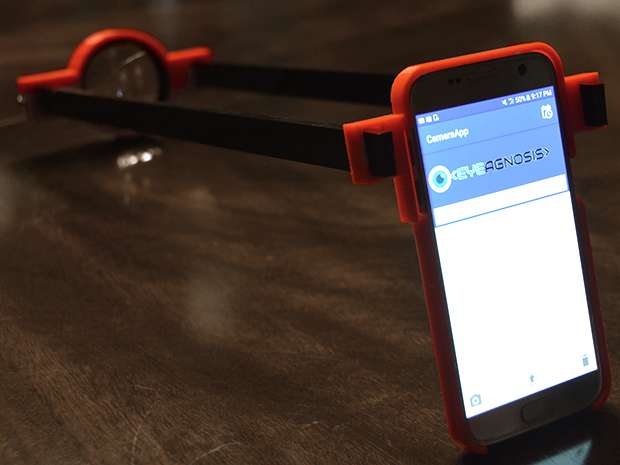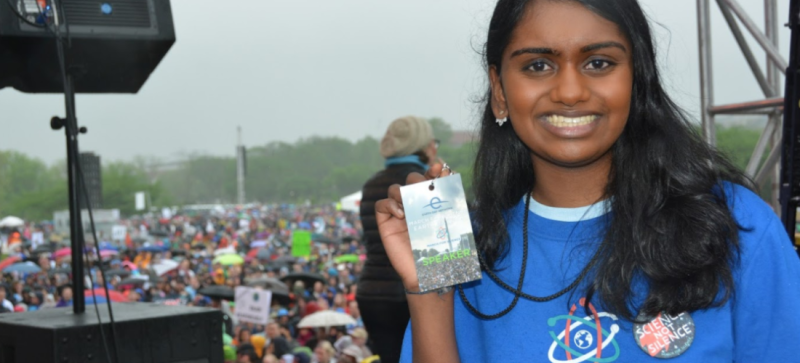August 10, 2017 weblog
Phone app, 3-D printed lens belong to teenager's system to screen for an eye disease

(Tech Xplore)—A teenage student has presented a system that is designed to diagnose an eye disease. Kavya Kopparapu, together with her 15-year-old brother, Neeyanth, and her high school classmate Justin Zhang, have come up with an artificial intelligence system to recognize signs of diabetic retinopathy, in photos of eyes, and to deliver a preliminary diagnosis.
They call it their Eyeagnosis system, which utilizes artificial intelligence techniques and also a smartphone camera for the screenings.
If you are trying to imagine what this is, The Verge described it as a 3-D-printed lens that, when fitted onto a smartphone and used with an app, was created to give the preliminary diagnosis.
It was cheap—cheap as in expensive—to make and the obvious advantage is that it would be a cheap, portable diagnosis system. In terms of world population areas with limited resources and people in poverty, it could support screening efforts in a broader population.
TechCrunch said the system is 3-D-printed. Devin Coldewey wrote about how it works:
"A 3-D-printed mount and lens lets retinal scans be taken with an iPhone, and a machine learning system using readily available services and trained on thousands of such images does the diagnosis."
She presented her work at an O'Reilly Artificial Intelligence Conference. The conference site described the event as a "a deep dive into emerging AI techniques and technologies with a focus on how to use it in real-world implementations."
Describing her presentation, it said, "The Eyeagnosis system is the first complete diagnostic pipeline to inexpensively capture and automatically grade retinal images in the field."
Kopparapu's motivation to do something of this sort is rooted in her family experience. Her grandfather, living in a small city on India's eastern coast, in 2013 began showing symptoms of diabetic retinopathy, said IEEE Spectrum. This is a complication of diabetes that damages blood vessels in the retina and can lead to blindness. Eventually he was diagnosed and treated.

Many may not be as fortunate to get screening and diagnosis. The AI conference notes mentioned the problem. "Many patients with diabetic retinopathy, particularly in rural or developing areas where the ophthalmologist to patient ratio may be less than 1:1,000, remain undiagnosed due to limited access to traditional diagnostic tools and screening specialists."
Ariel Bleicher, IEEE Spectrum, noted statistics worldwide. "Of 415 million diabetics worldwide, one-third will develop retinopathy. Fifty percent will be undiagnosed. Of patients with severe forms, half will go blind in five years. Most will be poor."
India's medical professionals would not be strangers to this kind of problem. There are programs where doctors who journey into villages and slums, but there are only so many ophthalmologists who can handle the numbers of people in need.
Question asked ini the article is, "What if there were a cheap, easy way for local clinicians to find new cases and refer them to a hospital?" This Eyeagnosis system might be a step at the least to support an answer.
So how did her team train an artificial intelligence system to recognize signs of diabetic retinopathy in photos of eyes? Bleicher outlined the different parts of the system and how they came together.
1.Working on the diagnostic AI part of the system, they chose a convolutional neural network as the machine-learning architecture. 2. Rather than build a network from scratch, she chose an off-the-shelf model developed by Microsoft researchers called ResNet-50. 3, said Bleicher. For training data, Kopparapu turned to the NIH EyeGene database.
She made arrangements with Aditya Jyot Eye Hospital, in Mumbai, for testing. She shipped her first 3-D-printed prototype for the system's lens to the hospital. "The complete Eyeagnosis system has already been tried on five patients at the hospital, and in each case it made an accurate diagnosis," Bleicher reported.
An expert in visual diseases at the National Institutes of Health (NIH) provided his reaction: "These kids have put things together in a very nice way that's a bit cheaper and simpler than most [systems designed by researchers]—who, by the way, all have advanced degrees!" J. Fielding Hejtmancik, in IEEE Spectrum, noted a long road toward clinical adoption, however.
"What she's going to need is a lot of clinical data showing that [Eyeagnosis] is reliable under a variety of situations."
More information: * Harnessing the power of artificial intelligence to diagnose diseases, conferences.oreilly.com/artifi … chedule/detail/62762
* Blog: compscikavya.wordpress.com/blog/
© 2017 Tech Xplore


















